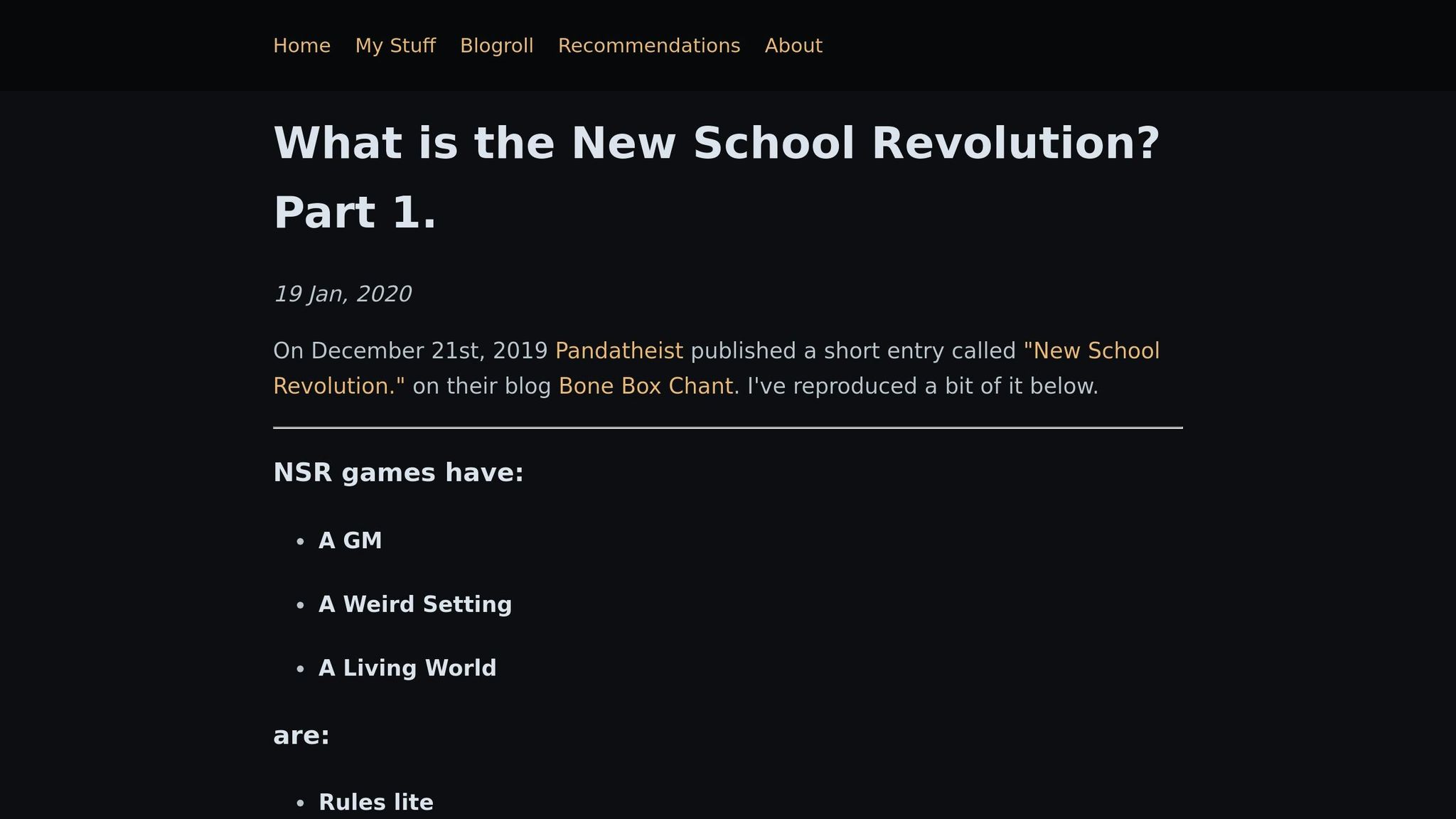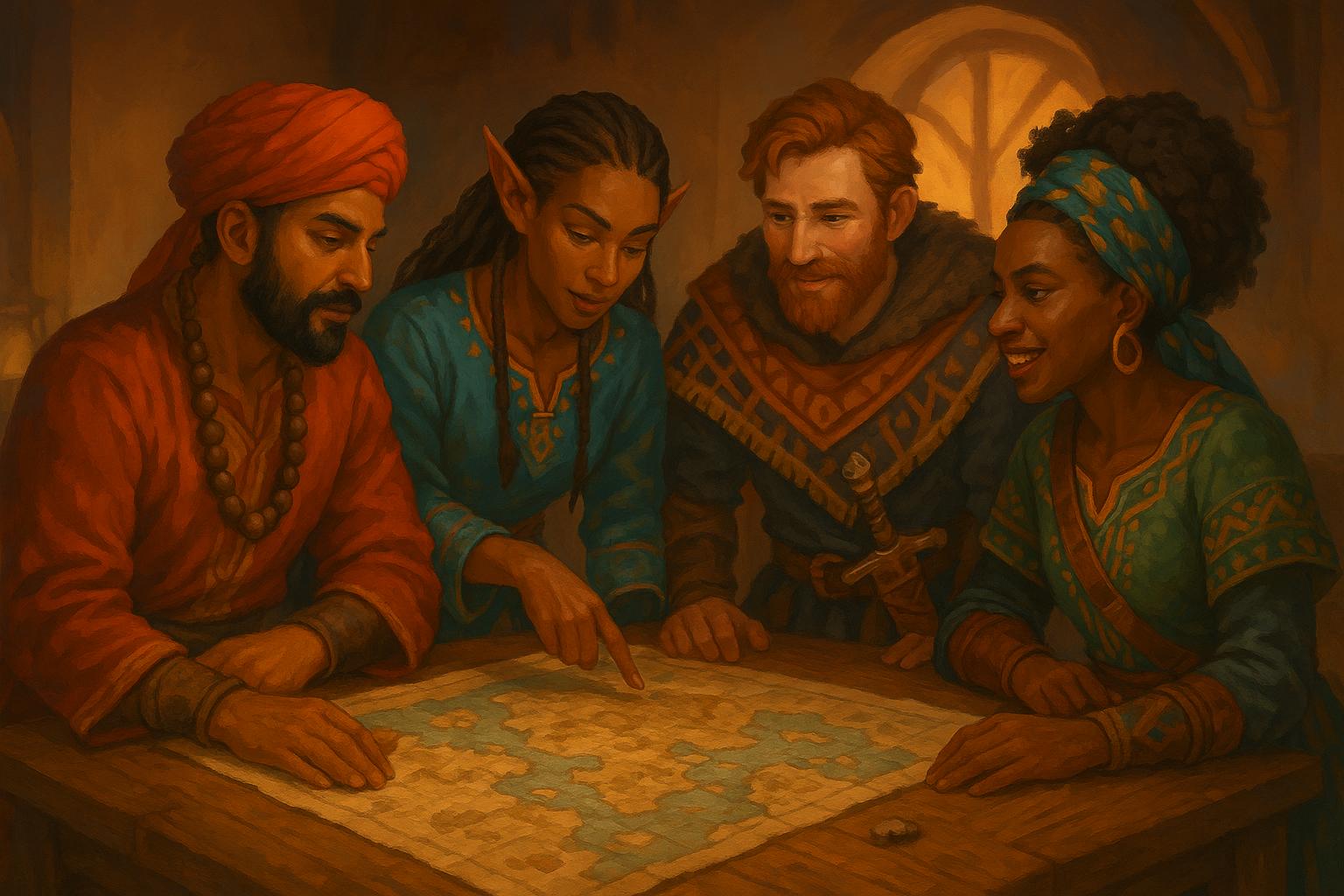Diegetic advancement in NSR (New School Revolution) games transforms how characters grow by tying their progression directly to the story. Instead of abstract level-ups, it focuses on in-game events, actions, and narrative milestones. Here's what you need to know:
-
What is Diegetic Advancement?
Characters progress naturally through the story, such as learning from failures, building alliances, or gaining skills through training. -
Why Use It?
It enhances immersion by removing traditional mechanics like XP or levels and replaces them with story-driven growth. -
Core Features:
- Growth through meaningful actions and failures.
- Skills and abilities gained via in-world experiences (e.g., training, exploration).
- Players shape the story with their choices.
-
NSR Principles:
- Player Agency: Players’ decisions directly impact the story.
- Narrative Integration: Mechanics support storytelling.
- Simplified Rules: Lightweight systems encourage creativity.
What Makes Diegetic Advancement Different
Diegetic advancement offers a fresh take on character development in tabletop RPGs. Instead of relying on abstract mechanics like traditional level-ups, this approach ties character growth directly to events and moments within the game world. It’s about characters evolving through their actions and experiences, making their progression feel more natural and integrated into the story.
Core Concepts of Diegetic Advancement
In most RPG systems, leveling up often means gaining stat boosts or new abilities in a way that feels detached from the narrative. Diegetic advancement flips this script by focusing on how characters interact with the world around them. Growth is measured through tangible, story-driven outcomes, such as:
- Building alliances through meaningful interactions
- Acquiring resources via exploration and creative problem-solving
- Earning reputation with factions based on actions and choices
- Developing skills through hands-on experience or training
This approach replaces arbitrary level-ups with narrative milestones, creating a progression system that feels more intertwined with the story and the world itself.
Why Use Diegetic Advancement
The appeal of diegetic advancement lies in its ability to immerse players deeply in the narrative. As TheRealUprightMan shared after a two-year campaign:
"At no time did anyone feel like power levels were imbalanced, no problems with role separation, and because everyone was constantly advancing, and always knew when a skill was getting close to going up, they just stopped worrying about it! That level/power fixation went away and they just worried about the story! It's incredibly immersive because there are no dissociative mechanics." – TheRealUprightMan
Game designer Gordian further explains:
"The advantage of this system is that it creates a powerful sense of immersion because character development is tied directly to their achievement of personal narrative milestones." – Gordian
To successfully incorporate diegetic advancement into your game, here are a few effective strategies:
- Milestone-Based Learning: Characters grow by engaging with the world - training, researching, or uncovering ancient knowledge. This replaces generic level-ups with story-driven moments of growth.
- Failure as Growth: Mistakes and setbacks become opportunities for characters to learn and evolve, adding depth to the narrative while ensuring progress continues.
- Progressive Challenges: Set milestones that grow more difficult over time. This keeps power progression balanced and encourages players to diversify their skills.
Main Rules of NSR Design
The design principles of NSR are deeply rooted in its dedication to immersive, story-driven gameplay. These rules aim to create adventures that emphasize player choice and narrative depth, all while keeping the mechanics streamlined. By doing so, NSR ensures that both the story and the players remain at the forefront of the experience.
Player Choice and Story Flow
At the core of NSR adventures lies player agency - the ability for players to make meaningful decisions that directly impact the game world. Christian Amauger captures this idea perfectly:
"Player agency is the heart of every thrilling adventure, the spark that lights the flame of immersion and engagement. It's the player's ability to make decisions and take actions that can alter the course of the game. It's the power to say, 'I want to do this,' and to see the world respond. It's the freedom to navigate the game world, interact with characters, solve problems, and, most importantly, shape the story."
To incorporate meaningful player choice into your design, consider these key strategies:
- Offer Multiple Paths: Create scenarios that allow players to approach challenges from various angles, encouraging creativity.
- Align Choices with Characters: Ensure decisions resonate with the characters' motivations and backstories.
- Show Consequences: Make the game world react visibly to player actions, reinforcing the connection between choice and outcome.
Carrie Patel, Narrative Director for Avowed, highlights the importance of genuine choices:
"The choice to be good, noble, honorable, et cetera doesn't really exist if you're not giving players an actual choice to do something different."
While these decisions shape the narrative, the simplicity of NSR's rules ensures the story remains dynamic and player-driven.
Simple Rules, Strong Stories
NSR thrives on minimalist mechanics designed to support the narrative rather than overshadow it. The philosophy is simple: fewer rules create more room for storytelling. This approach works seamlessly with diegetic advancement, which ties character progression to the story itself. Here's how it plays out:
- Focus on Milestones: Track character growth through significant story achievements rather than grinding for stats.
-
Turn Failure Into Growth: Use setbacks as opportunities for characters to evolve. As a wise voice once said:
"The greatest teacher, failure is."
-
Encourage Player Initiative: Build frameworks that inspire players to take charge of the story. As veteran designer OG puts it:
"Story is what the PCs did."
To bring these principles to life, here’s a practical framework:
| Design Element | Implementation Strategy & Benefit |
|---|---|
| Player Agency | Present open-ended challenges to inspire creative problem-solving. |
| Story Flow | Develop scenarios rooted in character goals and aspirations. |
| Rule Simplicity | Use "learn on roll" systems tied to varying levels of difficulty. |
| Advancement | Design milestones that progressively challenge players. |
In NSR, the simplicity of rules clears the way for stories that are shaped by the players themselves.
Adding Diegetic Advancement to Your Game
Story-Based Character Growth
Diegetic advancement, a key principle in NSR systems, ties character development directly to the events and interactions within the game world. According to a 2021 study, players find it more engaging when characters evolve through meaningful in-game experiences. To make this work in your game, design events that naturally offer opportunities for growth.
Think about how players can actively shape their characters' journeys. Here are some structured approaches to implement character development:
| Growth Element | Implementation Method | Expected Outcome |
|---|---|---|
| Personal Milestones | Track achievements tied to character goals | Deeper emotional investment |
| Training Systems | Require in-world mentors or knowledge sources | Realistic skill progression |
| Failure Growth | Mark stats after failed tests for future improvement | Encourages risk-taking and growth |
| Relationship Development | Build connections with NPCs to unlock new abilities | Opens social advancement paths |
While these elements enhance individual character arcs, incorporating a structured progression system ensures the game remains balanced and engaging.
Building In-Game Progress Systems
To complement organic character growth, establish clear in-game systems that guide advancement. Alexander Brazie emphasizes the importance of progression:
"Game progression is foundational to player retention and engagement but is often underestimated. It is a unique blend of systems and content design that engages and keeps us playing."
Here are some strategies, based on expert recommendations, to create effective progression systems:
- Design Clear Advancement Tracks: Develop systems where players earn advancement points through meaningful interactions, but limit point banking to avoid excessive power-gaming.
- Require Training and Effort: Make players engage with the game world - through quests, training, or research - to gain new abilities, rather than handing out automatic upgrades.
- Scale Challenges Over Time: Gradually increase the difficulty of milestones, encouraging players to diversify their characters rather than focusing solely on optimization.
These strategies align well with NSR principles, ensuring a balance between immersion and gameplay mechanics.
Sample NSR Game Mechanics
To see diegetic advancement in action, consider these examples inspired by NSR systems. W.F. Smith's work in Prismatic Wasteland illustrates this beautifully:
"The reason this method for increasing ability scores is diegetic (or at least more diegetic than other methods) is that the ability score increases as a result of what happens within the fiction - the character is learning by failure."
Here are a few practical mechanics based on NSR principles:
- Failure-Driven Growth: Players mark stats after failed tests. Once three marks are accumulated, the stat improves, creating a rewarding risk-reward loop.
- Magical Transformation: Characters gain abilities through direct interaction with powerful forces, such as acquiring control over the undead after exposure to a Lich's essence.
- Artifact-Based Development: Narratively significant magic items, curated by the GM, drive character advancement.
Gordian sums it up perfectly:
"The advantage of this system is that it creates a powerful sense of immersion because character development is tied directly to their achievement of personal narrative milestones."
These mechanics not only enhance the storytelling experience but also keep players immersed by making character growth feel like a natural extension of the game world.
sbb-itb-b8b00a5
Making Stories and Players Matter
Working with Players on Story
Creating meaningful narratives in NSR games starts with collaboration between the GM and players. A great way to kick this off is through a Session Zero, where everyone aligns on narrative themes and the level of control each participant will have over the story.
Here are some ways to bring players into the storytelling process:
| Story Element | How to Implement | Why It Matters |
|---|---|---|
| Player Input | Weave character backstories into the main plot. | Builds a stronger personal connection to the story. |
| World Building | Let players contribute details about locations and NPCs. | Makes the world feel more alive and collaborative. |
| Quest Design | Design missions with multiple ways to succeed. | Gives players more freedom and influence over outcomes. |
| Narrative Control | Share storytelling responsibilities at key moments. | Strengthens group engagement and ownership of the story. |
"A character's growth is measured not just by numbers on a sheet but by their influence in the fiction: the allies they've made, the resources they've gathered, the factions they've influenced." - Travis
By involving players in crafting the world and its stories, their choices gain weight, and the game becomes more immersive. This collaborative effort ensures that the narrative feels personal and dynamic, drawing everyone deeper into the experience.
As the story evolves, it's equally important to design rewards that reflect the risks players take and the impact of their decisions.
Making Rewards Worth the Risk
In NSR games, a well-designed reward system should feel like an extension of the narrative. When rewards tie directly to player actions and the risks they take, they add depth to the storytelling. To achieve this, consider integrating rewards that enhance the world-building and character growth, such as resources, hidden lore, or temporary boosts.
Here are some ideas to make rewards meaningful:
- Resource Distribution: Scatter balanced resources across the game world to encourage exploration and discovery.
- Knowledge and Secrets: Offer valuable information through traders, ancient texts, or hidden areas.
- Temporary Power Boosts: Provide situational advantages, like powerful items or abilities, that players can uncover during their adventures.
The game world should also respond to player actions. Christian Amauger puts it perfectly:
"Influence is what makes the game world feel alive and reactive, reinforcing the players' sense of agency by creating a visible link between their actions and the world's responses."
Conclusion: Building Better NSR Adventures
To craft memorable NSR adventures, weave character growth directly into the fabric of in-game events and consequences. As DREAMING DRAGONSLAYER aptly puts it:
"Advancement is best when it's diegetic, meaning when it happens IN THE GAME"
By tying progression to in-game accomplishments and player decisions, as explored earlier, you create a more immersive and story-rich experience.
Here’s a quick breakdown of how to incorporate diegetic advancement into your adventure design:
| Design Element | Implementation | Impact on Play |
|---|---|---|
| Advancement Triggers | Link character improvements to meaningful narrative moments | Encourages clear goals and rewarding progress |
| World Response | Let player actions shape the world and future storylines | Makes the game world feel alive and reactive |
These methods enhance NSR's focus on sleek, narrative-driven design that prioritizes meaningful growth over unnecessary mechanics.
NSR thrives when it trims excess and ensures every element has purpose. As recent game design discussions emphasize:
"XP itself and the idea of 'levels' could also stand to be cut from many games... Stats like Strength and HP have a direct impact whereas 'level,' especially in Into the Odd, has no true meaning. Cut the fluffy bits."
FAQs
How does diegetic advancement in NSR games create a more immersive experience for players?
Diegetic advancement in NSR games takes immersion to the next level by weaving character progression directly into the story and game world. Instead of relying on abstract systems like experience points or leveling up, characters evolve through in-world experiences. Think of learning a skill from a wise mentor, uncovering ancient secrets, or earning the trust of a powerful faction. These moments make progression feel like a natural part of the journey.
By syncing character growth with the narrative, players become more connected to their roles and the world around them. This method also promotes collaborative storytelling and gives players more control over their choices, making every decision feel meaningful. Unlike traditional systems, diegetic advancement turns progression into a story-driven experience that keeps players deeply engaged and emotionally invested.
How can game masters use milestone-based progression to enhance their campaigns?
Game masters can bring more depth to their campaigns by using milestone-based progression that revolves around story-driven achievements. The key is to establish clear milestones tied to major in-game events - like completing a critical quest, resolving a major conflict, or hitting an important turning point in the narrative. This way, character progression stays closely connected to the unfolding story rather than becoming a grind of repetitive tasks.
Make sure to communicate these milestones to your players so they can see how their actions shape their progression. When players understand how their efforts impact their advancement, it boosts their engagement and makes every achievement feel well-earned. You can also fine-tune these milestones to match your group’s interests and the overall storyline, keeping the experience flexible and engaging.
When it’s time to reward players, focus on meaningful, story-integrated benefits. Think of rewards like new abilities, unique resources, or exciting narrative opportunities instead of just handing out numerical stat boosts. This approach not only enhances immersion but also strengthens the bond between character growth and the game world’s evolving story.
How does player agency shape the story and character growth in NSR tabletop RPGs?
Player Agency in New School Revolution (NSR) Tabletop RPGs

One of the defining features of New School Revolution (NSR) tabletop RPGs is the emphasis on player agency. In these games, players aren't just following a predetermined script - they’re actively shaping the story and their characters’ journeys. NSR adventures evolve based on the choices players make, leading to dynamic and unpredictable narratives that keep every session fresh and engaging.
As players tackle challenges and make meaningful decisions, their characters naturally grow and change within the story. This approach not only deepens the emotional connection to the game but also creates richer and more personal character arcs. By putting creativity and decision-making at the forefront, NSR games give players the power to truly take charge of the story, delivering an immersive and rewarding experience for everyone at the table.


